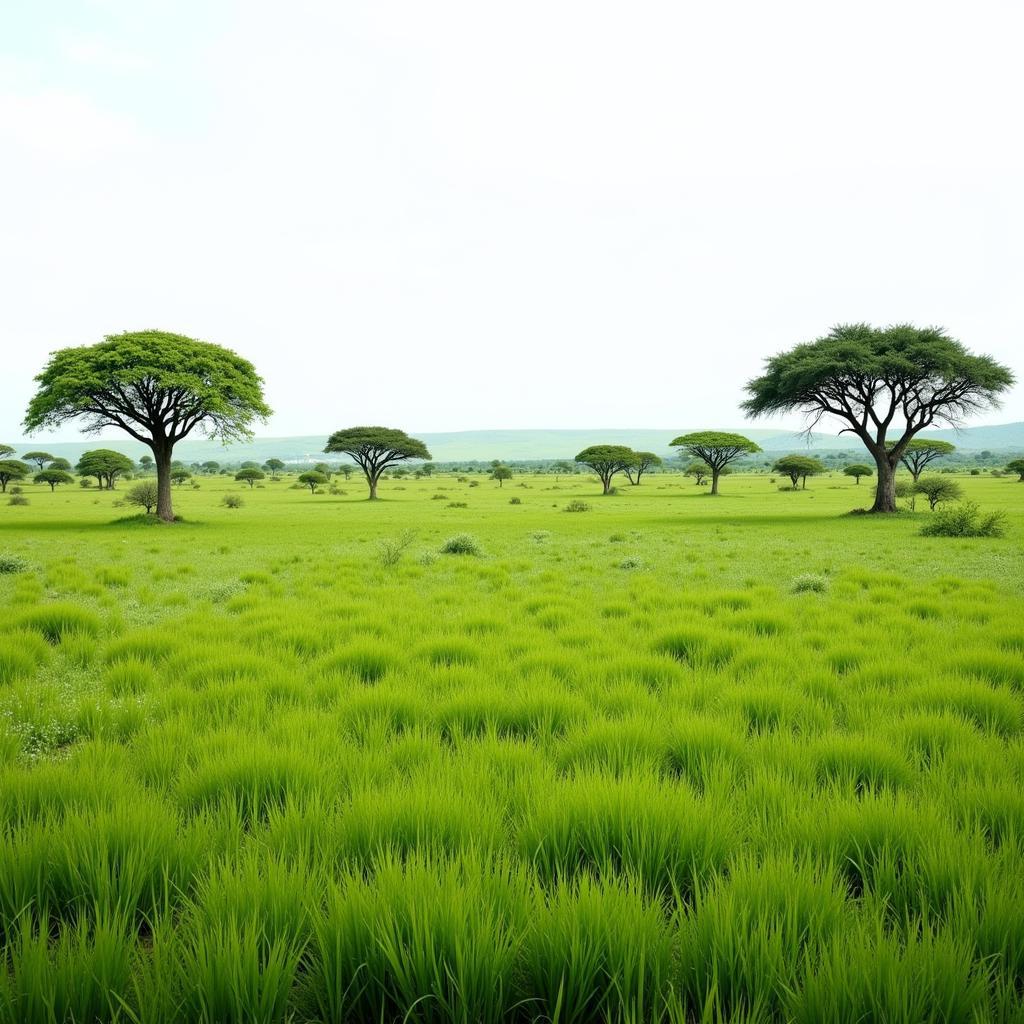Exploring the African Grass Forest Ecosystem
African Grass Forests, a unique blend of grassland and woodland, represent a fascinating ecosystem found across the African continent. These areas, neither entirely savanna nor dense forest, support a rich tapestry of life and play a crucial role in maintaining biodiversity. Understanding these transitional zones is vital for conservation efforts and appreciating the complexity of African landscapes.
What Defines an African Grass Forest?
African grass forests are characterized by a continuous grass layer interspersed with scattered trees, creating a mosaic habitat. Unlike pure savannas, where trees are widely spaced, or closed forests with a dense canopy, grass forests offer a middle ground. The density of trees can vary considerably, influencing the amount of sunlight reaching the ground and impacting the species composition. This combination of open grassland and wooded areas creates a diverse environment that supports a wide range of plant and animal life. This ecological niche plays a significant role in connecting different habitats, allowing for species migration and gene flow. After the initial rains, the grass grows rapidly, providing sustenance for a multitude of herbivores.
The African elephant plays a vital role in shaping the landscape of these forests, preventing the encroachment of dense woodland and maintaining the open areas necessary for grasses to thrive. You can learn more about these magnificent creatures by reading our article about the African elephant Africa.
 African Grass Forest Landscape with Scattered Trees and Abundant Grass Cover
African Grass Forest Landscape with Scattered Trees and Abundant Grass Cover
The Flora and Fauna of African Grass Forests
The vegetation in these forests is adapted to a range of conditions, from periodic fires to seasonal droughts. Grasses are the dominant plant form, with species like elephant grass and red oat grass thriving. Trees found in these areas are typically fire-resistant and drought-tolerant, such as acacias, baobabs, and various species of Combretum.
The diverse vegetation supports an equally diverse animal population. Large herbivores, including zebras, giraffes, and antelopes, graze on the abundant grass, while predators like lions, leopards, and cheetahs stalk their prey. Birds, reptiles, and insects also find refuge in the varied habitats offered by the grass forest ecosystem. You can learn more about the relocation of the African cheetah relocation to India.
Where are African Grass Forests Found?
African grass forests are found across a wide range of latitudes and altitudes, reflecting the diversity of the African continent. They are particularly prevalent in regions with a distinct wet and dry season, such as parts of East Africa, Southern Africa, and West Africa. Specific examples include the miombo woodlands of Southern Africa and certain areas within the Serengeti ecosystem.
The Importance of Conservation
African grass forests face numerous threats, including deforestation, habitat fragmentation, and overgrazing. These pressures can lead to biodiversity loss and disrupt ecological balance. Conservation efforts are crucial to protect these valuable ecosystems and the species that depend on them. Sustainable land management practices, community involvement, and protected area networks are essential for the long-term preservation of African grass forests. Understanding the intricate relationships within these ecosystems is vital for effective conservation strategies. The plight of the giraffe is a prime example of the challenges facing these ecosystems. Find out more by reading about the African giraffe endangered.
The African Dung Beetle’s Role
The African dung beetle plays a crucial role in maintaining the health and fertility of grass forests. These industrious insects process animal dung, improving soil structure, nutrient cycling, and reducing greenhouse gas emissions. Learn more about these vital creatures in our article about the African dungfish.
 Protecting African Grass Forests for Future Generations
Protecting African Grass Forests for Future Generations
Conclusion
African grass forests are dynamic and vital ecosystems that contribute significantly to the biodiversity of the African continent. Understanding the characteristics, distribution, and conservation challenges of these unique landscapes is essential for preserving their ecological integrity for future generations. Supporting sustainable practices and promoting awareness are key steps towards ensuring the long-term health of African grass forests.
FAQ
- What is the main difference between a savanna and a grass forest? Grass forests have a higher density of trees compared to savannas.
- What are some of the threats to African grass forests? Deforestation, habitat fragmentation, and overgrazing.
- Why are African grass forests important? They support a rich biodiversity and play a crucial role in ecosystem health.
- Where are African grass forests typically found? Regions with distinct wet and dry seasons across Africa.
- What types of animals live in African grass forests? Large herbivores, predators, birds, reptiles, and insects.
- What kind of trees are common in African grass forests? Acacias, baobabs, and various species of Combretum.
- How can we help conserve African grass forests? Supporting sustainable land management practices and conservation initiatives.
Other Common Questions
- What is the role of fire in African grass forests?
- How do climate change impacts these ecosystems?
- What are the economic benefits of preserving these areas?
Other Articles You Might Find Interesting
- The Impact of Climate Change on African Wildlife
- Traditional Uses of Plants in African Medicine
- Exploring the Cultural Diversity of African Communities
For any assistance, please contact us at Phone Number: +255768904061, Email: kaka.mag@gmail.com, or visit us at Mbarali DC Mawindi, Kangaga, Tanzania. We have a 24/7 customer support team.

